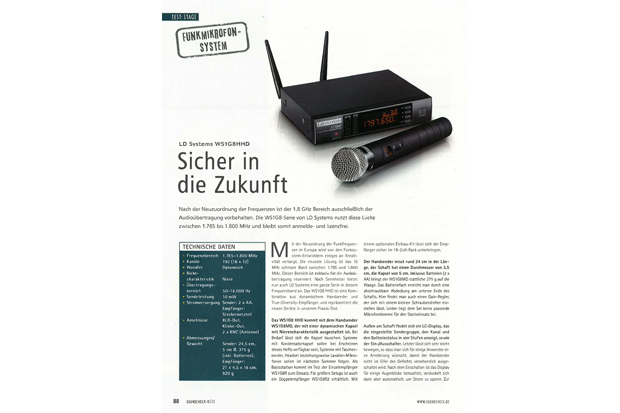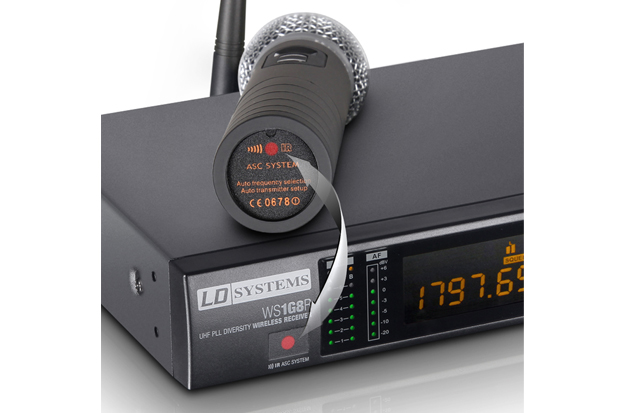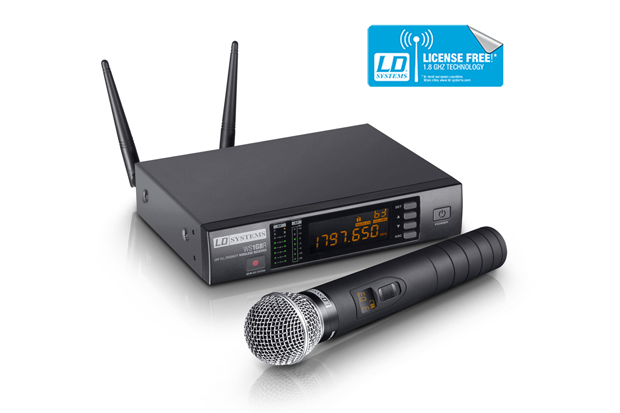LD Systems WS 1G8 HHD – Futureproof – Test Report by Soundcheck
After reallocation of the frequencies, the 1.8 GHz band is reserved exclusively for audio transmission. The WS 1G8 Series by LD Systems uses this gap between 1785 and 1800 MHz and thus remains registration and license free.

The reallocation of radio frequencies in Europe is demanding a lot of creativity on the part of wireless system developers. The latest solution is the narrow 15-MHz-wide band between 1785 and 1800 MHz. This band is reserved exclusively for audio transmission. After Sennheiser, LD Systems is also offering an entire series in this frequency band. The WS 1G8 HHD is a combination of dynamic handheld transmitter and true diversity receiver, and represents the new devices in our practical test.
The WS 1G8 HHD comes with the WS 1G8 MD handheld transmitter, which is equipped with a dynamic microphone capsule with a cardioid directional characteristic. If necessary, the capsule can be exchanged. Systems with condenser capsules should be available by the time this issue appears. Systems with a belt pack transmitter, headset or lavaliere microphone should follow next summer. The base station used in the test is the WS 1G8 R single receiver. For larger setups, a WS 1G8R 2 dual receiver is also available. The optional installation kit lets you house the receiver securely in a 19″ rack.
The handheld transmitter is approximately 24 cm long. The shaft has a diameter of 3.5 cm; the capsule has a diameter of 5 cm. Including batteries (2 x AA), the WS 1G8 MD weighs in at a stately 375 g. Access to the battery compartment is provided by a screw-mounted cover at the lower end of the shaft. Here there is also a gain control that can be adjusted using a small screwdriver. Regrettably, the set does not include a matching microphone clamp for use on a stand.

On the outside of the shaft is an LC display that indicates the selected transmitter group, the channel, and the battery status in four stages, as well as an on/off switch. Unfortunately, the later moves very easily. It would be nice if it could be locked in position for some applications in order to avoid switching off the handheld transmitter accidentally in the heat of the battle. After power-on, the display is illuminated for a few moments, then goes dark automatically in order to conserve power. For automatic channel selection, the hand transmitter is also equipped with an infrared module. The transmitter power is the maximum permitted in the 1.8 GHz band: 10 milliwatts.
The WS 1G8 R true diversity receiver takes up half a rack space, is powered by a power adapter, and comes from the factory with two removable antennas. When used in a rack, it is also possible to connect external antennas via the TNC sockets. The rear panel also offers a balanced XLR output and an unbalanced TRS output. The front panel has a large, easy-to-read LC display (illuminated orange), two six-segment LED meters for the signal strength of both antennas, a seven-segment LED indicator for the transmitted audio signal, four control buttons, an on/off switch, and a infrared module for automatic channel scanning (“ASC”) between transmitter and receiver. The radio system can transmit and receive in sixteen groups of 12 channels each. Thus a total of 192 channels is possible, which should enable a typical band to find enough frequencies to play together with wireless mics and guitar transmitters. The squelch function, which suppresses noise, is adjustable in three stages; the output volume is adjustable from 00 to 63.

The LD Systems WS 1G8 HHD is a snap to set up: all you have to do is hook up the receiver, attach and aim the antennas, and turn on the transmitter and receiver. If they aren’t already on the same channel, press the ASC button on the receiver to start the channel scan and point the bottom of the handheld transmitter at the red dot on the front of the receiver. At a distance of up to 20 cm, the channel scan takes only a few seconds. If the selected channel is already in use or susceptible to interference, by pressing the Set button longer and using the arrow buttons, you can either select the group and channel manually or activate the automatic channel scan.
The WS 1G8 delivers a good signal, even through two plasterboard walls and at a distance of 30 to 40 metres. With a direct line of sight, even more is possible. This is just fine for a system with a recommended retail price of EUR 349.00. We have to subtract a few points, however, for the basic sound of the handheld transmitter. A lot of work with the EQ is required in order to make the system sound good. Moreover, there is audible noise. In the treble range, the level of the WS 1G8 MD takes a sharp, sudden dive starting at 11,000 Hz. In order to increase the brilliance, you would like to add a little more between 3,000 and 4,000 Hz. At 1,500 Hz, on the other hand, there is a slight spike that must be dialled back to keep vocals from sounding too nasal. While a solid signal is delivered in the range between 100 and 300 Hz, the level drops noticeably already in the lower midrange. Thus the dynamic capsule is not the first choice for singers, who should watch out for the condenser capsule instead. This is supposed to provide significantly finer resolution for vocals.
AT A GLANCE
LD Systems WS 1G8 HHD
Distributor: Adam Hall, www.ld-systems.com
Price: (RRP) € 349
+ Simple operation
+ Rugged workmanship
+ Fast setup
– Microphone clamp not included
– On/off switch is not lockable
Complete product information is available here:
http://www.ld-systems.com/en/series/ws-1g8-series/ws-1g8-hhd-wireless-microphone-system-with-dynamic-handheld-microphone/
Source: Soundcheck Magazin, Germany
Author: Ulrich Simon
Leave a Comment
You must be logged in to post a comment.












